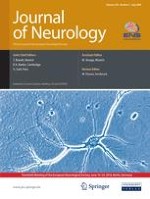Published in:

01-07-2009 | Original Communication
Ischemic stroke of the cortical “hand knob” area: stroke mechanisms and prognosis
Authors:
Nils Peters, Stefanie Müller-Schunk, Tobias Freilinger, Marco Düring, Thomas Pfefferkorn, Martin Dichgans
Published in:
Journal of Neurology
|
Issue 7/2009
Login to get access
Abstract
Cortical ischemic stroke affecting the precentral “hand knob” area is a rare but well known stroke entity. To date, little is known about the underlying stroke mechanisms and the prognosis. Twenty-nine patients admitted to our service between 2003 and 2007 were included in the study on the basis of an acute ischemic infarct of the cortical “hand knob” area confirmed by diffusion-weighted magnetic resonance imaging with contralateral hand paresis. For all patients clinical, epidemiological as well as imaging data at the time point of admission were analysed retrospectively and follow-up data on all patients was obtained. The majority (n = 21/72%) had an isolated infarct of the cortical “hand knob” area. In 23 (79%) patients it was a first ever stroke. Ten patients (34%) had ipsilateral extracranial stenosis of the internal carotid artery (ICA), whereas potential cardiac embolic sources were less frequent (n = 4/14%). No patient exhibited ipsilateral MCA stenosis. All but two patients (93%) had marked atherosclerotic alterations of the ICA. Hypertension was the most prevalent vascular risk factor (n = 23/79%). At follow-up (mean 25.0 months, range 0.4–47.4 months) no patient had died and only one (3%) experienced a recurrent stroke. The majority of patients (79%) reported improvement of hand paresis, 17 (59%) were asymptomatic (modified Rankin score = 0). Only one patient was significantly disabled due to a recurrent stroke. In conclusion, ischemic infarcts affecting the cortical “hand knob” area are frequently associated with atherosclerotic changes of the carotid artery, suggesting an arterio-arterial thrombembolic stroke mechanism. It mostly reflects first ever ischemic stroke, and follow-up data suggest a rather benign course.